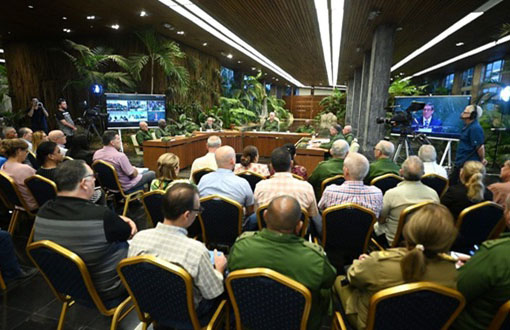
Havana, November 7 - Miguel Díaz-Canel Bermúdez, President of the National Defense Council, led a meeting this Thursday, broadcast on the television program "From the Presidency," to assess the recovery in the eastern provinces following Hurricane Melissa, according to the website Cubadebate.
The president highlighted that, despite damage to more than 70,000 homes and thousands of collapses, there were no fatalities, a result of the evacuation of more than a million people, according to official data.
In his address, he emphasized that the popular response was decisive, with proposals for immediate solutions from local authorities and communities, which allowed for progress in the rehabilitation of more than two thousand homes and the partial restoration of electricity and communications.
The National Institute of Water Resources reported that Las Tunas has restored 100 percent of its water supply, while Santiago de Cuba has reached 33 percent coverage and remains a priority as it has the highest number of affected people.
Guantánamo reported an 87 percent restoration of water service, and Holguín 68 percent, with works underway to normalize supply in Moa and Gibara. Granma will receive water purification plants to ensure drinking water in flooded communities.
Óscar Pérez Oliva Fraga, Vice Prime Minister and head of Foreign Trade, stated that international aid began to arrive even before the storm hit, with resources pre-positioned by the United Nations system and donations from countries such as Germany, Norway, Canada, Venezuela, Colombia, and India.
Joaquín Alonso, Minister of Economy and Planning, confirmed that technical brigades and state resources were mobilized for the recovery, and that legal and sanitary measures are being applied to prevent crimes and epidemics in the affected areas.
Beatriz Johnson Urrutia, president of the Provincial Defense Council in Santiago de Cuba, reported that more than 63,000 homes were damaged and that 26,000 tons of cement have been distributed for reconstruction, with priority given to cleanup and the restoration of communications.
Joel Queipo Ruiz, president of the Provincial Defense Council of Holguín, specified that 299,000 people were protected and that 65 percent of customers now have electricity.
In Granma, Yudelkis Ortiz Barceló, president of the Provincial Defense Council, stated that 64 percent of the electrical service has been restored, more than 200 schools have resumed the school year, and two municipalities in the region, Río Cauto and Cauto Cristo, remain in the alarm phase due to flooding.
Vicente de la O Levy, Minister of Energy and Mines, indicated that Las Tunas has achieved a 97.8 percent recovery of electrical service, while Guantánamo is working to reconnect to the National Electroenergetic System.
Tania Margarita Cruz Hernández, First Deputy Minister of Public Health, reported 642 affected health institutions in the east, of which four percent have already been recovered, and assured that medical brigades and epidemiological control teams remain deployed in the provinces.
Naima Ariatne Trujillo Barreto, Minister of Education, confirmed that more than 50 percent of the damaged educational institutions have resumed classes, with local solutions such as classrooms in homes and a gradual reopening in Santiago de Cuba.
Authorities agreed that the most complex stage will be the recovery of road and housing infrastructure, a process that will require weeks of coordinated work between state agencies and communities. (Text and photo: ACN)